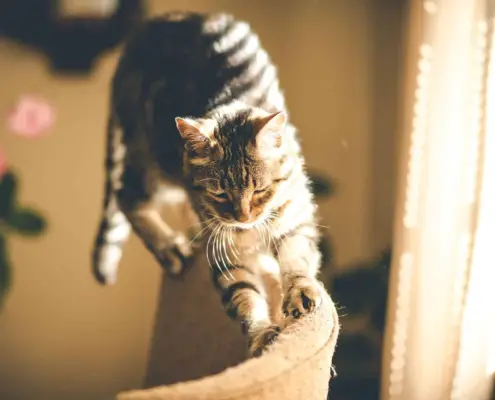
Cats are fascinating creatures, known for their agility, curiosity, and keen senses. One of the most remarkable aspects of a cat’s sensory system is their eyesight. Cat owners often marvel at their pet’s ability to spot the tiniest movement or see clearly in the dark. In this article, we will delve into the incredible eyesight of cats, exploring the anatomy of their eyes, their visual acuity, the limitations of their vision, and how far they can see.
Understanding the anatomy of a cat’s eye
To comprehend the unique eyesight of cats, it is essential to understand the anatomy of their eyes. Like humans, cats have corneas, pupils, irises, and retinas. However, there are some distinct differences. Cats have vertical pupils that can dilate widely, enabling them to control the amount of light entering their eyes more effectively. Additionally, they possess a tapetum lucidum, a reflective layer behind the retina that enhances their ability to see in low light conditions. This adaptation gives their eyes that mesmerizing glow at night.
The visual acuity of cats
Visual acuity refers to the ability to see fine details. While humans are known for having exceptional visual acuity, cats are not far behind. Studies have shown that cats have a higher number of photoreceptor cells in their retinas compared to humans. This abundance allows them to perceive more detail in their surroundings. However, their vision is optimized for detecting movement rather than focusing on stationary objects. This explains why cats can spot a small prey or toy from a distance.
The limitations of a cat’s vision
Despite their impressive visual acuity, cats do have some limitations in their vision. One significant limitation is their color perception. Cats are dichromats, meaning they can only see a limited range of colors. They have fewer color receptors in their retinas compared to humans, which results in a reduced ability to distinguish between certain shades. Another limitation is their depth perception. Cats rely on their binocular vision to judge distance accurately, but it is not as precise as that of humans. This is why cats may sometimes misjudge the distance when pouncing on their prey.
How far can cats see?
Cats have excellent distance vision, thanks to their exceptional eyesight. On average, a cat can see objects clearly up to 100 feet away. However, their visual acuity decreases significantly as the distance increases. While they can spot movements from afar, the ability to discern fine details diminishes with distance. Nevertheless, this remarkable long-range vision is a valuable asset for cats in the wild, allowing them to spot potential threats or prey from a safe distance.
The role of night vision in a cat’s eyesight
One of the most astonishing aspects of a cat’s eyesight is their ability to see in the dark. This is achieved through their specialized night vision. As mentioned earlier, cats possess a tapetum lucidum, which reflects light back through the retina, enhancing their sensitivity to low light conditions. Additionally, their pupils can dilate to a larger extent than humans, allowing more light to enter the eyes. These adaptations make cats highly efficient hunters during the night, giving them a significant advantage over their prey.
Comparing a cat’s vision to human vision
While cats have several visual advantages, their vision differs significantly from that of humans. Humans are trichromats, meaning they have three types of color receptors, allowing them to perceive a wide range of colors. Cats, on the other hand, have only two types of color receptors, resulting in a more limited color spectrum. Humans also have better depth perception and can judge distances more accurately. However, cats excel in low light conditions and have superior peripheral vision, allowing them to detect movements from various angles.
Tips for optimizing a cat’s visual environment
Understanding the unique eyesight of cats can help us create an environment that maximizes their visual experience. Providing ample opportunities for visual stimulation, such as toys and window perches, can keep a cat’s eyes engaged and prevent boredom. Additionally, ensuring proper lighting, especially during nighttime, can help cats utilize their night vision effectively. Regular check-ups with a veterinarian can also help identify any eye problems early on, ensuring optimal visual health for your feline companion.
Common eye problems in cats and how to detect them
Despite their remarkable eyesight, cats are prone to various eye problems. Some common issues include conjunctivitis, cataracts, glaucoma, and retinal disorders. It is crucial for cat owners to be vigilant and watch out for signs of eye problems. Symptoms such as redness, excessive tearing, squinting, cloudiness, or changes in pupil size should not be ignored. If any of these signs are observed, it is essential to consult a veterinarian promptly to prevent any potential vision loss or discomfort for the cat.
Appreciating the unique eyesight of cats
In conclusion, the eyesight of cats is truly incredible. Their ability to see in the dark, spot tiny movements, and have excellent distance vision is a testament to their exceptional visual system. While cats may have some limitations in their vision, their unique adaptations make them highly skilled hunters and fascinating companions. By understanding their eyesight and taking appropriate measures to optimize their visual environment, we can ensure that our feline friends have a happy and healthy life.
If you enjoyed my article, I would appreciate you sharing it with your network.

Sima Ndlebe
Sima writes for CatBuzz. He is interested in Cats, Health and Fitness, and Entrepreneurship.
Published: 28 April 2024




